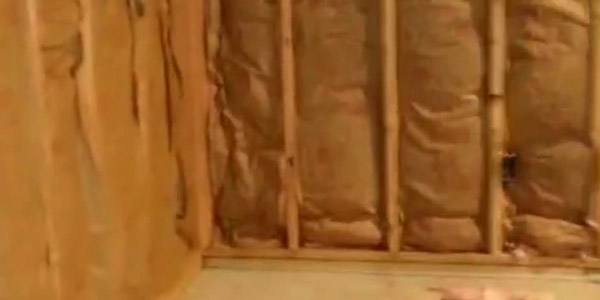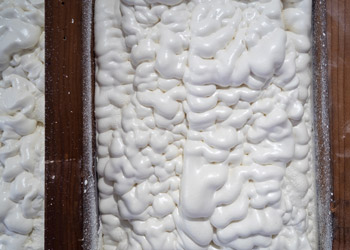R-value is a metric for measuring how much resistance a material can put up against heat. It has more to do with controlling the temperature than dampening noise. However, some materials have soundproofing properties to block out the noise from traffic or nearby construction sites without affecting their thermal regulation ability.

However, not all R-values are suitable or excellent at soundproofing. So, is R15 Insulation Good for Soundproofing? If not, what other R-values have superior noise-blocking performance?
So, let’s find out:
What is R15 insulation?
Insulating your home has many benefits, from keeping your space warm to reducing energy costs. Another noticeable perk of home insulation is a quiet space.
Hence, homes near busy roads or lousy areas enjoy the massive benefits of having thick insulation. A home free from one of the leading noise pollution sources.

At this moment, the R15 and R13 are some of the best noise-canceling insulations. Homeowners often use these spray foam insulation to soundproof their offices, basement, and garage.
The R15 insulation comes in two types: faced and unfaced soundproofing insulation material. The formal has a barrier on its head, while its counterpart is used to complement an existing insulator. The R15 is an effective noise and thermal regulator when used on 2×4 walls and cavities.
Most importantly, different materials require different thicknesses to achieve R15 insulation. Depending on the material, the thickness can range from 2.5 to 5 inches.
R15 & Insulation Material Thickness
Each insulation material has an R-value rating per inch thickness. Achieving a heat resistance rated R15 means you need several layers of insulation material. In short, materials with higher R-values require less thickness.
For example, R15 batt insulation needs about a 4-inch thickness, while R15 rigid foam insulation demands a less 3-inch thickness. As you can see, the required thickness varies depending on the original R-value of the material.
So let’s dive deeper into them.
Fiberglass batt insulation R15 thickness
When it comes to insulation, this is most homeowners’ favorite, and the reasons are not far-fetched. They are inexpensive and offer the best of both worlds – thermal and noise insulation.
This type of insulation is best used when insulating your existing wall. It is available in different thicknesses. However, you can add more layers to increase its thickness for better energy efficiency and noise reduction.
Additionally, fiberglass insulation is a perfect blend of plastic polymers and glass. While this material is not as durable as rock wool, foam board, and cellulose, it has a natural fire-resistant property.
The fiberglass batt has a 3.6 – 5 R-value, which means you need at least a 4-inch thickness to get the R15 insulation.
Loose-fill Fiberglass R15 Thickness
The loose-fill fiberglass is an ideal choice if you want to soundproof and thermally insulate your basement and attics.
This lightweight loose-fill fiberglass is super durable. It’s indestructible by sharp objects. It’s not as dense as fiber batt, which explains why it requires 5 inches of thickness to acquire an R15 value. Nonetheless, it’s one of the cheapest ways to increase your wall’s R-value.
Sadly, its loose structure causes moisture vapor to pass through. Hence, it requires a vapor barrier within the wall to preclude the growth of mildew in your home.
Closed-cell Spray Foam R15 thickness
Spray foam insulation is one of the affordable ways to soundproof your home. Most homeowners prefer closed-cell spray foam because of its eco-friendliness. It has the highest R-value of 6.5, which means it demands the least thickness of 2.5 inches for R15 insulation.

Consequently, it works best for places with limited space. It’s a more convenient option to add insulation to areas that won’t permit thick ones. This foam is mainly made up of polyurethane, which is liquid but quickly cures and becomes a hard surface.
They are great for sealing cracks and gaps to avoid air leaks. Their air-tight structure offers one of the best acoustic protection and thermoregulation.
Open-cell Spray Foam R15 Thickness
Spray foam insulation consists of two chemicals, which mix and expand to fill ceiling and wall cavities. They create an air-tight seal once sprayed onto your house’s ceiling and wall. It makes the perfect insulation barrier to keep the external elements, including noise, out of your home.

In contrast, the open cell spray foam is more suitable for insulating ceilings and roofs since it requires more thickness to achieve R15. For walls, the closed-cell alternative is the best bet.
It requires less thickness to get the desired soundproofing and thermal insulation performance. Open-cell spray foam has an R-value of 3.5 and needs at least a 4-inch thick layer to create an R15 insulation result.
Related FAQs
There are only a few differences between both R-values. The higher the R-value, the better its performance. So, you should expect R15 to be more efficient than R13. The formal will resist heating better than the lower R13 insulation.
If your walls feature 2 x 4 studs, then you can’t go wrong with R15 insulation. Also, consider the R13 insulation if your modern wall is not up to 4 inches thick.
R-value is often used to measure the heat resistance of a material. This metric can also give valuable insight into how well the material can block out external noise. Insulation materials are excellent at maintaining your home’s warmth and preventing sound from penetrating through the wall. The best R-value should stop sound and air from traveling through the walls or reduce the sound wavelength at least.
Conclusion
There are many R-values to pick from, and you would get different levels of soundproofing and energy efficiencies. But the right one to pick usually hinges on your budget, building design, and climate.
However, the R15 is your best choice if you need to soundproof 2 x 4 walls and cavities. It works well in any climatic condition in the US. Plus, it makes an excellent insulation choice for crawl spaces, basements, and floors.
Note: This R-value insulation is not recommended for use in attics.
Related Resources:
